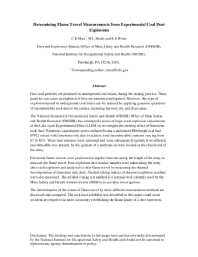Mining Publication: Determining Flame Travel Measurements from Experimental Coal Dust Explosions
Original creation date: September 2010
Authors: C Man, ML Harris, ES Weiss
NIOSHTIC2 Number: 20037629
Proceedings of the Eighth International Symposium on Hazards, Prevention, and Mitigation of Industrial Explosions, September 5-10, 2010, Yokohama, Japan. Japan: Keio University, ISH013, 2010; :1-10
Fine coal particles are produced in underground coal mines during the mining process. These particles can cause an explosion if they are entrained and ignited. However, this type of explosion hazard in underground coal mines can be reduced by applying generous quantities of incombustible rock dust to the entries, including the roof, rib, and floor areas. The National Institute for Occupational Safety and Health (NIOSH) Office of Mine Safety and Health Research (OMSHR) has conducted a series of large-scale explosion experiments at the Lake Lynn Experimental Mine (LLEM) to investigate the inerting effect of limestone rock dust. Numerous experiments were conducted using a pulverized Pittsburgh coal dust (PPC) mixed with limestone rock dust to achieve total incombustible contents varying from 67 to 82%. These dust mixtures were entrained and were subsequently ignited, if insufficient incombustible was present, by the ignition of a methane-air zone located at the closed end of the entry. Electronic flame sensors were positioned at regular intervals along the length of the entry to measure the flame travel. Post-explosion dust residue samples were taken along the entry after each explosion and analyzed to infer flame travel by measuring the thermal decomposition of limestone rock dust. Alcohol coking indices of the post-explosion residues were also measured. The alcohol coking test method is a forensic tool currently used by the Mine Safety and Health Administration (MSHA) in accident investigations. The determination of the extent of flame travel by these different measurement methods are discussed and compared. The rock dust solubility test described in this paper could assist accident investigators in more accurately establishing the flame limits of a dust explosion.

NIOSHTIC2 Number: 20037629
Proceedings of the Eighth International Symposium on Hazards, Prevention, and Mitigation of Industrial Explosions, September 5-10, 2010, Yokohama, Japan. Japan: Keio University, ISH013, 2010; :1-10
- Coal Dust Explosibility
- Coal Dust Explosibility Meter Evaluation and Recommendations for Application
- Coal Dust Particle Size Survey of US Mines
- Differential Pressure Response of 25-mm-Diameter Glass Fiber Filters Challenged with Coal and Limestone Dust Mixtures
- Evaluation of the Bagged Stone Dust Barrier Effectiveness in a Bord and Pillar Mine
- How Does Limestone Rock Dust Prevent Coal Dust Explosions in Coal Mines?
- Mitigating Coal Dust Explosions in Modern Underground Coal Mines
- Rock Dusting
- Rock Dusting Considerations in Underground Coal Mines
- Technology News 515 - Float Coal Dust Explosion Hazards